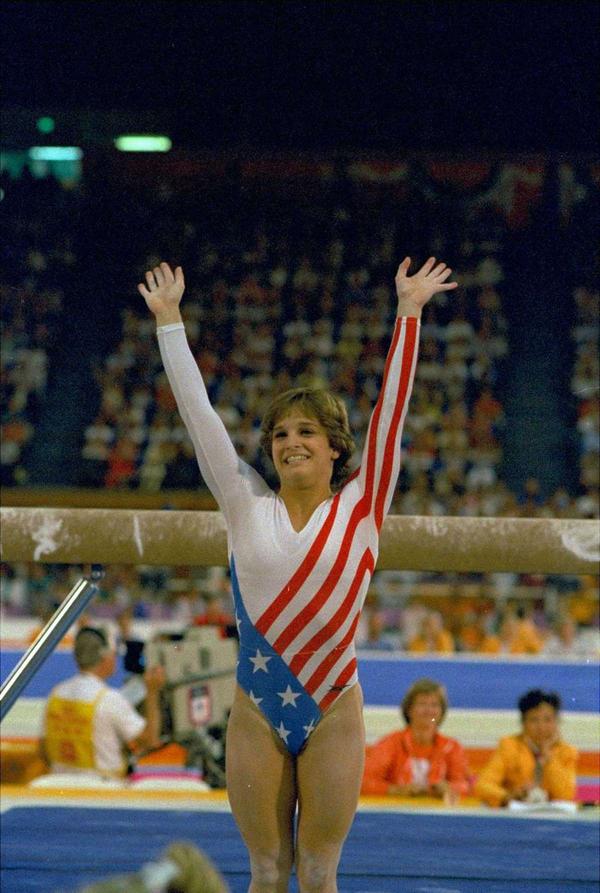In the summer of 1984, a spunky high school sophomore with an electric smile vaulted her way into America’s hearts. With a victory margin of 0.5 points, Mary Lou Retton became the first American female gymnast to win the Olympic individual all-around gold medal and left the 1984 Los Angeles Games as a sensation.
The impact of the Fairmont, West Virginia-native's victory was almost immediate—on and off the gymnastics mat.
The silver medal-winning women’s team was feted at a celebration at famed entertainer Bob Hope’s house in Los Angeles. Retton and her teammates enjoyed a trip to Disneyland and a ticker tape parade in New York with other U.S. medalists. She landed on the cover of a Wheaties box, the first female athlete to adorn the front, and was named the Sportswoman of the Year by
Sports Illustrated
.
More importantly, though, Retton made women's gymnastics must-watch TV and laid the foundation for future American stars such as Nastia Liukin, Suni Lee, Simone Biles and others. In the year after her five-medal showing in Los Angeles—Retton also won two bronze and two silver medals—gymnastics club enrollments in the United States grew by more than 40 percent, according to the sport's governing body.
By the end of 1984, Retton—all 4-foot-9 inches, 93 pounds of her—was arguably America’s most famous woman.
“It was so immediate, and intensely so,” 1984 U.S. women's gymnastics team captain Kathy Johnson says of Retton's dramatic rise in prominence.“... We were in L.A., after all, the entertainment capital of the world. It exploded in the biggest, most dramatic way, partly because this is America. It just grew exponentially.”
A Gold-Medal Performance Full of Drama
Mary Lou Retton and other U.S. Olympians were saluted at a ticker tape parade in New York in 1984.
Allan Tannenbaum/Getty Images
The 1984 Games had been
boycotted
by the Soviet Union and several of its allies, four years after the United States and 64 other countries boycotted the Moscow Olympics. The Soviets almost certainly would have been favored for the gold, but the U.S. team was intent on having its own golden moment.
“Half our team was on the 1980 team that didn’t get to go—and there was such emotion and such passion,” Johnson says. “Not just among the athletes, but the entire country, to see an Olympics.”
Retton's gold-medal moment was full of drama. On August 3, 1984, she entered the final night of competition leading 35 other women in the gymnastics all-around event, including presumptive favorite Ecaterina Szabo of Romania, who trailed by only .15 of a point.
But heading into her final event—the vault—Retton needed a perfect 10 score to claim the gold medal. She had to stick the landing. Retton promised her coach, Bela Karolyi, she would.
READ MORE:
10 Historic Moments of Olympic Hype and Heartbreak
Moments later, Retton soared and twisted through the air, pulling off a difficult d
ouble Tsukahara, before coming down for that perfect landing. For a moment time stood still. Then “10.00”—a perfect score—flashed on the scoreboard."We did it, Little Body!" Karolyi screamed as he hugged Retton after her vault. "We did it! Unbelievable!"
Recommended for you
Eight Memorable Protests by American Athletes

The Patriot Financier Who Bankrolled the Revolutionary War
10 Extraordinary Pro Football Hall of Fame Classes
"I knew the takeoff was good," Retton, then 16, told reporters, "and I knew the vault was good. And I knew I'd stick it."
"Biggest vault ever," Karolyi said.
A "prodigy, a new wave in gymnastics," the
Los Angeles Times
called her in the newspaper the next day.
For Valorie Kondos Field, one of the more successful American gymnastics coaches in history, what came after Retton's perfect vault sent shivers down her spine.
“When she vaulted and got a 10, she didn’t have to do a second vault,” she says. “She did because she could, and I remember in that moment thinking, ‘This is what sports should be. It’s about playing the game. Not just about getting the medal and winning.’”
Retton Still Popular Years After Los Angeles Games
Mary Lou Retton remains in demand as a motivational speaker.
Getty Images
Prior to Retton, many other female athletes made huge impacts, from all-around athletes Babe Didrikson Zaharias and Althea Gibson, to tennis stars
Billie Jean King
and Chris Evert. But none of them became a pop culture icon like Retton.
“[She] changed the landscape of not just gymnastics," Johnson says, "but I think women in sports. It literally transported us to a whole new level.”
READ MORE:
Eight Astounding Moments in Women's Olympic Gymnastics
Years after her gold-medal moment, Retton remains one of the most popular faces of the
Olympic Games
. In 1993, she was voted "Most Popular Athlete in America" in a survey by the Associated Press. She performed on "Dancing With Stars" in 2018, still appears in television commercials, and remains in demand as a motivational speaker. Every four years, she’s thrust right back into the limelight.
“She was so different than any other gymnast,” says Johnson, who won a bronze in the balance beam at the 1984 Games. “..., She was this mighty mite. Short brown hair, bouncing all over the place. Unique and powerful beyond words. She instantly grabbed the attention of the world and didn’t let go.”
Kondos Field says Retton's relatability is what set her apart from other gymnasts.
“What I have found in coaching gymnasts like the ones who’ve gone viral—it’s not the stereotypical gymnast," she says. "They’re relatable young women who happen to excel at gymnastics. ... [Retton] was muscular, she was powerful."
And, Kondos Field adds, "she beamed from ear to ear.”




